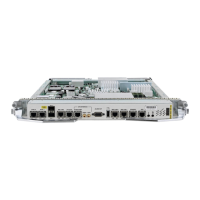negotiation auto
!
interface GigabitEthernet0/5/0/6.1 l2transport
encapsulation untagged
rewrite ingress tag push dot1q 200 symmetric
ethernet egress-filter strict
!
l2vpn
bridge group examples
bridge-domain r2-bridge
interface GigabitEthernet0/5/0/4.1
!
interface GigabitEthernet0/5/0/5.1
!
interface GigabitEthernet0/5/0/6.1
!
!
!
!
These assumptions are made:
• Customer traffic entering router R1 is trunked, that is all traffic is tagged. The only untagged traffic is
the protocol traffic, which arrives from the customer network.
• The Customer-facing interfaces GigabitEthernet 0/1/0/1 at router R1 and Gigabit Ethernet 0/5/0/5 at
router R2 belong to the same customer. Customer-facing interfaces GigabitEthernet 0/1/0/2 at router R1
and GigabitEthernet 0/5/0/6 at router R2 belong to a different customer.
• Traffic from different customers remain segregated.
• Only L2 protocol traffic is sent through the customer-facing interfaces.
• L2 protocol traffic entering the customer-facing interfaces is untagged.
• Traffic must be L2PT encapsulated to successfully pass through the switch cloud.
The purpose of this topology is that router R1 and R2 must receive customer protocol traffic from multiple
customer interfaces, and multiplex the traffic across a single service provider interface and link. At the
decapsulation end, the reverse is performed. Traffic entering router R1 on the GigabitEthernet subinterface
0/1/0/1.1 exits router R2 from the GigabitEthernet subinterface 0/5/0/5.1 only while traffic entering router
R1 at GigabitEthernet subinterface 0/1/0/2.1 exits router R2 from GigabitEthernet subinterface 0/5/0/6.1 only.
A protocol frame entering router R1 on GigabitEthernet interface 0/1/0/1 travels through the network in this
manner:
• The protocol frame is directed to GigabitEthernet subinterface 0/1/0/1.1, as the frame is untagged.
• The rewrite statement with GigabitEthernet subinterface 0/1/0/1.1 causes a tag of ID 100 to be added to
the frame.
• The frame enters router R1’s bridge domain r1-bridge.
• The bridge (r1-bridge) floods the frame to all attachment circuits (AC) on the bridge domain, except the
originating AC (split horizon AC).
• Ethernet egress filtering on GigabitEthernet subinterface 0/1/0/2.1 detects a tag ID mismatch, and drops
the frame. In this way, the bridge domain’s flooded traffic is prevented from exiting other customer
interfaces.
L2VPN and Ethernet Services Configuration Guide for Cisco ASR 9000 Series Routers, IOS XR Release 6.3.x
44
Ethernet Features
L2PT in the Reverse Mode with Protocol Frame Tagging

